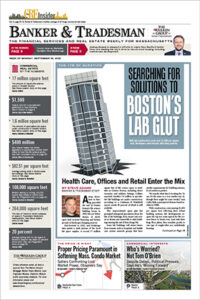
Suburban multifamily development is likely to benefit the most from potential interest rate cuts, brokers and developers predict, while Boston’s construction climate remains challenging. iStock photo
Approval of the first Federal Reserve interest rate cut since 2024 could help solve the financial equation for some multifamily developers seeking to break ground on the next wave of projects.
The Federal Reserve Board’s policy meeting begins Tuesday amid widespread anticipation of a 0.25 to 0.5 percent drop in its benchmark short-term interest rate, and potentially more to come.
Even if this week’s cut is likely already priced into the market, the outcome could prompt construction of more suburban apartment projects in Greater Boston, industry experts predict.
“To me, it’s optimism,” said Andrew Kaeyer, executive vice president at Hunneman in Boston. “Everybody feels better that values will stabilize or go up, and lenders feel better that loans on their balance sheet are able to be refinanced.”
A rate cut could spur refinancing of projects that received loans in the past few years, Kaeyer said.
“These people built projects and then the rates went up by 200 basis points,” he said. “They thought they could refinance at 5 percent and now it’s 6.5 percent and they couldn’t.”
Lower-Cost Sites Newly Available
Suburban development conditions are already improving in the wake of the MBTA Communities law’s loosening of zoning restrictions on multifamily housing. In many communities, the law has added underutilized commercial properties with low acquisition costs to the inventory of potential multifamily development sites.
Low acquisition costs remain a key part of the equation for projects to hit their profitability targets, said Michael Buckley, a partner at Avison Young in Boston.
“Are you in a location where the land doesn’t have too much [cost] baggage and where the demographics point to rent growth? MBTA Communities has really opened the window, and those are great and other deals will happen in similar communities,” Buckley said.
But construction cost escalation from the Trump administration’s tariff policies remain a wild card, however, potentially erasing the benefits of lower rates. Some industry research projects hard-cost increases of up to 10 percent from tariffs, Buckley said.
And conditions remain challenging in the city of Boston proper, with its effective 20 percent affordable housing requirement for projects with seven or more units and new “net zero carbon” zoning requirement for new construction, developers say.

WSQ Development and Eaglebrook Capital are proposing a 52-unit apartment complex replacing an office building at 108 Water St. in Watertown. It’s one of the first two buildings proposed under the city’s MBTA Communities zoning. Image courtesy of PCA
Suburban Savings Increase Viability
The value proposition is strong in the suburbs, where developers can save on site acquisition costs and construction costs, Kaeyer said. That points to an uptick in housing production.
“If you can surface-park it, it helps reduce your costs pretty dramatically. You’ve got to get creative in Boston in how to stage a project,” he said. “The style of the project that you’re building is cheaper construction than what you have to build in Boston, and a lot of money did move out to the suburbs because of costs.”
Lower minimum affordability requirements in the suburbs provide higher income, helping projects hit their profitability targets, Kaeyer added.
By contrast, housing developers in Boston continue to struggle with the city’s 17 percent affordability requirement and 3 percent Section 8 voucher-holder set-aside for projects with seven or more units, even after the Wu administration signaled some flexibility on the policy earlier this year.
Following double-digit increases following COVID, higher construction costs have persisted, said Josh Brandt, founder of Stack + Co., a developer and third-party builder in Boston.
The October 2024 update to Boston’s inclusionary development policy has made it harder to finance small projects, requiring income-restricted units in all developments with seven or more units, Brandt said. Previously, projects under 10 units were exempt.
“If they raised the IDP minimum back up to nine units, you’d see a lot of shovels,” Brandt said. “It’s not that developers have anything opposed to affordable housing, aside from the fact that you can sell the units at [only] half of what they cost. And the margins on the market-rate units aren’t that big.”

Steve Adams
Smaller Projects Gravitate Toward Condos
In both Boston and suburban markets, profit margins remain razor-thin for developers, brokers and developers say.
Developers of smaller projects in Boston are gravitating toward for-sale condominiums, which offer the prospect for higher returns in the current environment, said Sean Kelly-Rand, managing partner at RD Advisors.
“If somebody is going to do a ground-up construction project under 20 units, it’s all condos,” said Kelly-Rand, whose firm provides short-term financing for new construction, condo conversions and fix-and-flip projects. “The math still works better, even though the market has cooled.”
Year-to-date, the median sales price of condominiums in Boston’s core neighborhood was $903,000 as of July 31, according to data compiled by The Warren Group, publisher of Banker & Tradesman. That figure represents a 7 percent year-over-year decrease.
In Dorchester, it’s $589,000, a 1.8 percent drop.
Condo sales velocity is slowing across the state and in Greater Boston. The inventory of unsold units has increased 59.5 percent on a year-over-year basis in Greater Boston, according to the Massachusetts Association of Realtors.
The sluggish sales climate could threaten financing for future condo conversions and construction, Kelly-Rand said, as developers have to wait longer to sell out projects.
“A lot of projects haven’t moved as quickly,” he said. “A builder hasn’t sold, inventory is growing and somebody isn’t getting back from that project. I’ll speak with investors who say, `I’d love to invest, but I’m just waiting to get my money back from this project or that project.’ There’s less money to go around, and a lot of capital is locked up.”





